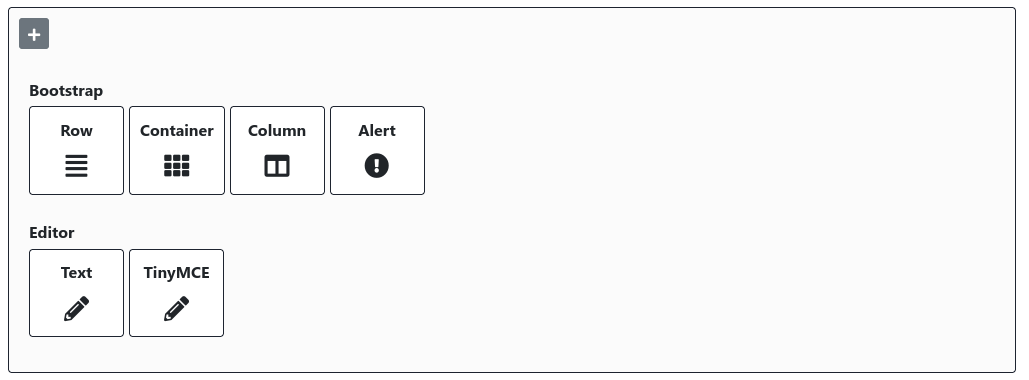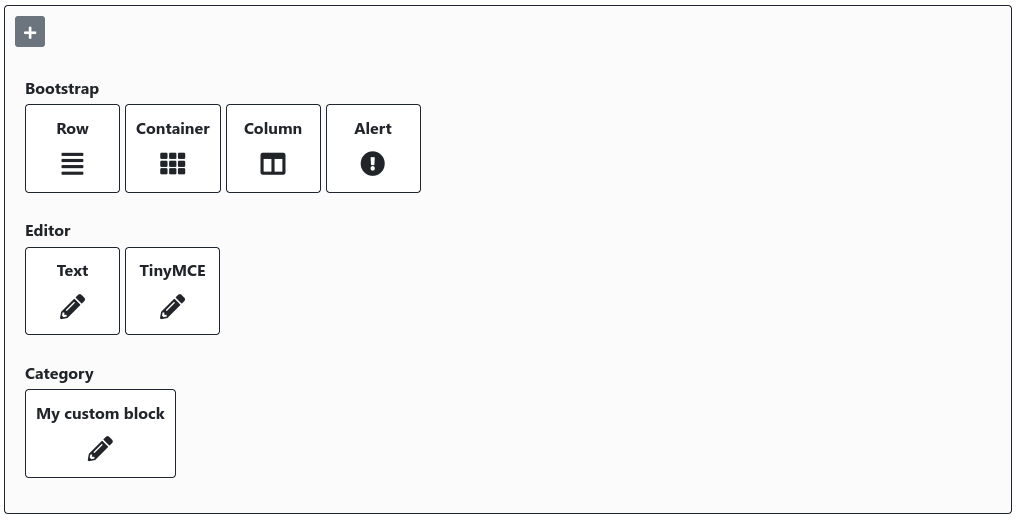Builder Block
Its gives you total control to build with blocks.


Add the builder in forms
Classic form
src/Form/ExampleType.php
namespace App\Form\ExampleType;
use App\Core\Form\Type\BuilderType;
use Symfony\Component\Form\AbstractType;
use Symfony\Component\Form\FormBuilderInterface;
class ExampleType extends AbstractType
{
public function buildForm(FormBuilderInterface $builder, array $options)
{
$builder->add(
'myField',
BuilderType::class
);
// ...
}
// ...
}
Page form
src/Entity/Page/YourPage.php
namespace App\Entity\Page;
use App\Core\Entity\Site\Page\Block;
use App\Core\Entity\Site\Page\BuilderBlock;
use App\Core\Form\Site\Page\BuilderBlockType;
use Symfony\Component\Form\FormBuilderInterface;
#[ORM\Entity]
class YourPage extends Page
{
public function buildForm(FormBuilderInterface $builder, array $options)
{
$builder->add(
'myBlock',
BuilderBlockType::class,
[
'label' => 'My block',
'row_attr' => [
],
'options' => [
// options given to the sub form
],
]
);
// ...
}
public function setMyBlock(Block $block)
{
return $this->setBlock($block);
}
public function getMyBlock(): Block
{
return $this->getBlock('myBlock', BuilderBlock::class);
}
// ...
}
Create a template:
templates/page/your_page/default.html.twig
{% extends 'base.html.twig' %}
{% block page %}
{{ _page.myBlock.value|block_to_html }}
{% endblock %}
Creating custom block
The easy way is to run: php bin/console make:builder-block.
First, create a service which extends App\Core\BuilderBlock\BuilderBlock and tagged builder_block.widget.
Then, implement the method configure as below.
src/BuilderBlock/CustomBlock.php
namespace App\BuilderBlock;
use App\Core\BuilderBlock\BuilderBlock;
use Symfony\Component\DependencyInjection\Attribute\AutoconfigureTag;
#[AutoconfigureTag('builder_block.widget')]
class CustomBlock extends BuilderBlock
{
public function configure()
{
$this
->setName('custom')
->setCategory('Category')
->setLabel('My custom block')
->setOrder(1)
->setIsContainer(false) // set `true` if the block can contain blocks
->setIcon('<i class="fas fa-pencil-alt"></i>')
->setTemplate('builder_block/custom.html.twig')
->setClass('col-md-12')
->addSetting(name: 'value', label: 'Value', type: 'textarea', attributes: [], default: 'Default value')
;
}
}
Create a template:
templates/builder_block/custom.html.twig
<div id="{{ id }}">
{{ settings.value|default(null) }}
{# If it's a container: #}
{% for item in children %}
{{ item|block_to_html(context) }}
{% endfor %}
</div>
That's all folks!

Rendering
To render blocks, simply use {{ value|block_to_html }}.
If you need to build variables depending of the content, you can override the method buildVars:
src/BuilderBlock/CustomBlock.php
namespace App\BuilderBlock;
use App\Core\BuilderBlock\BuilderBlock;
use Symfony\Component\DependencyInjection\Attribute\AutoconfigureTag;
#[AutoconfigureTag('builder_block.widget')]
class CustomBlock extends BuilderBlock
{
// ...
public function buildVars(array $data, array $context)
{
$this->vars['bar'] = 'bar';
}
}
And you can access variables in the template: